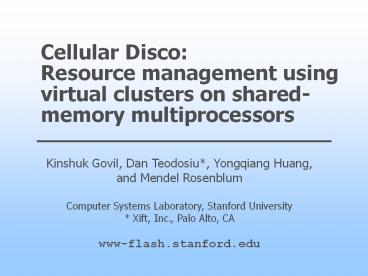Cellular Disco: Resource management using virtual clusters on shared-memory multiprocessors - PowerPoint PPT Presentation
Title:
Cellular Disco: Resource management using virtual clusters on shared-memory multiprocessors
Description:
Cellular Disco: Resource management using virtual clusters on shared-memory multiprocessors Kinshuk Govil, Dan Teodosiu*, Yongqiang Huang, and Mendel Rosenblum – PowerPoint PPT presentation
Number of Views:166
Avg rating:3.0/5.0
Title: Cellular Disco: Resource management using virtual clusters on shared-memory multiprocessors
1
Cellular DiscoResource management using virtual
clusters on shared-memory multiprocessors
Kinshuk Govil, Dan Teodosiu, Yongqiang Huang,
and Mendel Rosenblum Computer Systems
Laboratory, Stanford University Xift, Inc.,
Palo Alto, CA www-flash.stanford.edu
2
Motivation
- Why buy a large shared-memory machine?
- Performance, flexibility, manageability, show-off
- These machines are not being used at their full
potential - Operating system scalability bottlenecks
- No fault containment support
- Lack of scalable resource management
- Operating systems are too large to adapt
3
Previous approaches
- Operating system Hive, SGI IRIX 6.4, 6.5
- Knowledge of application resource needs
- Huge implementation cost (a few million lines)
- Hardware static and dynamic partitioning
- Cluster-like (fault containment)
- Inefficient, granularity, OS changes, large apps
- Virtual machine monitor Disco
- Low implementation cost (13K lines of code)
- Cost of virtualization
4
Questions
- Can virtualization overhead be kept low?
- Usually within 10
- Can fault containment overhead be kept low?
- In the noise
- Can a virtual machine monitor manage resources as
well as an operating system? - Yes
5
Overview of virtual machines
Virtual Machine
- IBM 1960s
- Trap privilegedinstructions
- Physical to machineaddress mapping
- No/minor OS modifications
App
OS
Virtual Machine Monitor
Hardware
6
Avoiding OS scalability bottlenecks
Cellular Disco
CPU
CPU
CPU
CPU
CPU
CPU
CPU
. . .
Interconnect
32-processor SGI Origin 2000
7
Experimental setup
IRIX 6.2
Cellular Disco
vs.
32P Origin 2000
- Workloads
- Informix TPC-D (Decision support database)
- Kernel build (parallel compilation of IRIX5.3)
- Raytrace (from Stanford Splash suite)
- SpecWEB (Apache web server)
8
MP virtualization overheads
20
10
4
1
- Worst case uniprocessor overhead only 9
9
Fault containment
VM
VM
VM
Cellular Disco
- Requires hardware support as designed in FLASH
multiprocessor
10
Fault containment overhead _at_ 0
1
1
1
-2
- 1000 fault injection experiments (SimOS) 100
success
11
Resource management challenges
- Conflicting constraints
- Fault containment
- Resource load balancing
- Scalability
- Decentralized control
- Migrate VMs without OS support
12
CPU load balancing
VM
VM
VM
VM
VM
VM
Cellular Disco
13
Idle balancer (local view)
- Check neighboring run queues (intra-cell only)
- VCPU migration cost 37µs to 1.5ms
- Cache and node memory affinity gt 8 ms
- Backoff
- Fast, local
CPU 0
CPU 1
CPU 2
CPU 3
A0
A1
VCPUs
B1
B0
B1
14
Periodic balancer (global view)
4
- Check for disparity in load tree
- Cost
- Affinity loss
- Fault dependencies
1
3
A0
A1
B0
B1
B1
15
CPU management results
9
0.3
- IRIX overhead (13) is higher
16
Memory load balancing
VM
VM
VM
VM
Cellular Disco
17
Memory load balancing policy
- Borrow memory before running out
- Allocation preferences for each VM
- Borrow based on
- Combined allocation preferences of VMs
- Memory availability on other cells
- Memory usage
- Loan when enough memory available
18
Memory management results
Only 1 overhead
DB
DB
Cellular Disco
Cellular Disco
4
4
32 CPUs, 3.5GB
Interconnect
Interconnect
- Ideally same time if perfect memory balancing
19
Comparison to related work
- Operating system (IRIX6.4)
- Hardware partitioning
- Simulated by disabling inter-cell resource
balancing
16 process Raytrace
TPC-D
Cellular Disco
8 CPUs
8 CPUs
8 CPUs
8 CPUs
Interconnect
20
Results of comparison
- CPU utilization 31 (HW) vs. 58 (VC)
21
Conclusions
- Virtual machine approach adds flexibility to
system at a low development cost - Virtual clusters address the needs of large
shared-memory multiprocessors - Avoid operating system scalability bottlenecks
- Support fault containment
- Provide scalable resource management
- Small overheads and low implementation cost































